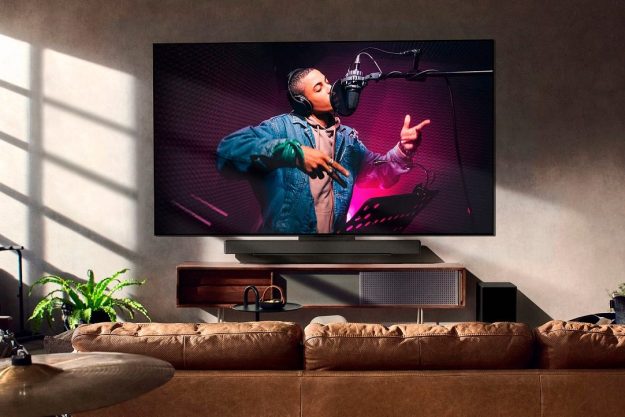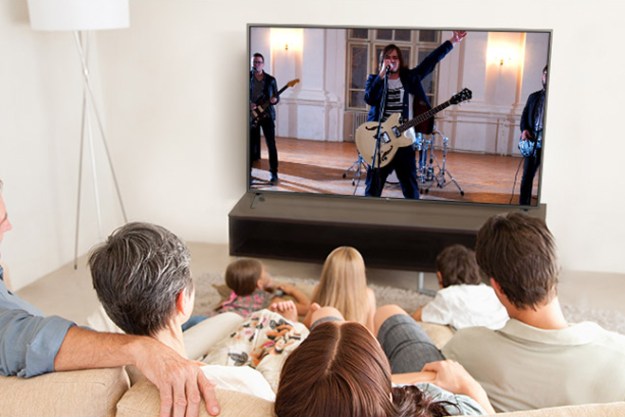Well, it’s spending tens of millions of dollars to support HDTV. That’s a start.
It was the first time that attending a press event scared me half to death. It wasn’t the event itself – it was the scene. This was my first trip to Time Warner’s new twin towers, jutting into the sky high above Columbus Circle in New York City. Let’s face it, nowadays, twin towers aren’t quite the safest places to be. Just going past the shiny glass-sheathed buildings on the bus makes me nervous. Nonetheless, duty called, and turning down free food is against my ethical code as a journalist, so I took the elevator to the Mandarin Oriental restaurant and its commanding view of the city.
The occasion was a major one. Samsung has struck a deal with eight companies, representing 95 percent of U.S. cable subscribers, to promote the cable industry’s growing involvement in delivery of high-definition television. The cable operators include Adelphia, Bright House, Charter, Comcast, Cox, Insight, Mediacom, and Time Warner (or as it was known until recently, AOL Time Warner, bwahahaha!). Comcast was missing from the list for reasons not fully explained at the press conference.
An unspecified eight-figure sum will be spent for joint advertising and promotion to raise awareness of the fact that you can get HDTV via cable. You may have already seen the initial results in ads accompanying the NCAA March Madness basketball tournament.
The move comes just when Samsung and many other HDTV makers are about to launch a new generation of cable-friendly products. Not only will these new sets work well with your cable signal – they’ll actually eliminate the need for a set-top cable box.
To receive premium channels, as well as cable staples like CNN, you’ll be able to plug a CableCARD directly into the set. The CableCARD will contain the necessary decryption to confirm that you’ve paid for the programming. To receive the broadcast channels delivered by your cable system, you may not even need the card. Under a deal struck between the TV-making and cable industries, and approved by the FCC, cable companies are required to enable CableCARDs with card-compatible HDTVs by July 1, 2004.
Now, you probably think that as a wise-cracking journalist, I’m going to rib Samsung and the cable industry a little. But, ignoring the fact that they fed me, I think what they’re doing is fantastic and I congratulate Samsung and CTAM warmly. What they’re doing just might make my life a lot easier.
Hey, I’m a captive of the cable industry myself. My Manhattan fortress is a desirable address but it also effectively prevents me from receiving a usable satellite or broadcast signal. I barely even receive a usable FM radio signal. So my cable company is my only source of TV, including HDTV, and the prospect of being able to dump my cable box is a pleasant one. You mean I can just plug a card into a cool flat-panel TV and watch cable – Two remotes, not one – Pinch me, I must be dreaming!
Why, then, am I telling you all this? Well, I want to know how this little drama plays out at your end. Please, readers, tell me the following:
– Do you currently receive HDTV via cable? Are you satisfied with the service? If you (or your neighbor) have a second feed – satellite or broadcast – how does the picture quality compare?
– How many of your local broadcast channels does your cable operator deliver in its system? Some cable systems claim they haven’t enough bandwidth to deliver all local channels.
– Have you noticed that your cable TV rates have been going up much faster than the Consumer Price Index? OK, that may be a rhetorical question.
If you’re reading this after July 1, 2004, here are a few more things I’m curious about:
– If you buy one of the new CableCARD-enabled HDTVs, does the technology work smoothly? I’m about to buy one and see for myself but I’d like to know about your own experience.
– Does your CableCARD-enabled HDTV deliver higher-quality video than a cable box feeding a component video signal to an older HDTV? It should look better because component video connections, which are analog, require extra stages of digital-to-analog and analog-to-digital conversion.
If you want to complain about anything else, go right ahead!
I’ve at least one complaint of my own: the FCC-approved deal mentioned above also included a provision requiring the cable companies to deliver cable boxes with IEEE-1394 outputs by December 31, 2003. Better known as FireWire, the 1394 interface allows high-def signals to be recorded and networked. Mitsubishi in particular is a big supporter of 1394.
But when I asked for an upgraded cable box two months after the December deadline, my operator gave me the run-around. Even identifying myself as a member of the press and promising to make nice (hey, quit snickering) didn’t do me any good. Three people passed the buck and I never got a straight answer or a new box.
But if I buy a CableCARD-enabled flat panel to supplement my front-projector – I need something less monolithically large to watch the 10 o-clock news on – that complaint will become irrelevant. I won’t need a cable box anymore; I’ll just have to make sure I buy a set with a 1394 output to pass the signal through. Then my high-def feed will be eligible for a TiVo-esque treatment.
Of course, I’m assuming that the cable industry will implement the CableCARD on time – keeping its commitment to the FCC, the HDTV makers, and us. I hope they’ll take that responsibility more seriously than Time Warner is taking my request for a 1394-equipped cable box.
As part of its deal with CTAM, Samsung will send a team of trainers to 65 percent of the retail locations selling its product. Their mission: to get store personnel to tell consumers that the HDTVs they’re buying can get a high-def signal from their friendly local cable operators.
I wonder aloud how much the cable industry is doing to educate its own customer-service personnel about HDTV. A lot of them still can’t distinguish between HDTV and DTV without the H. Not all digital TV is high-definition. Remember that when someone tries to sell you a fat package of digital channels – few of those channels will be high-def.
Even so, the cable industry has come a long way since those dark days when a cable box would output a signal only through channel 3 or 4, thereby subjecting the signal to degradation because it had to pass through two different TV tuners. Now the cable companies not only deliver HDTV but are actually spending money to promote it.
Mark Fleischmann is the author of Practical Home Theater (http://www.quietriverpress.com/).
Tell Mark what you think about CableCARD, and if you have any answers to his questions in our forum discussion.
Editors' Recommendations
- Samsung’s stunning ‘Frame’ QLED TV is up to $1,402 off
- Hisense’s PX3-Pro Laser Cinema gets AI, a bigger picture, and better sound
- Don’t miss your chance to get this 75-inch TV for less than $450
- This 40-inch TV is under $150 right now, and it’s selling fast
- This LG TV has a bendable OLED screen (really) and it’s $999 off


